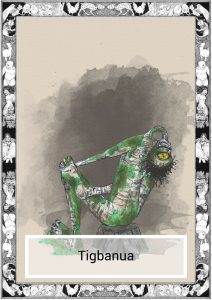Bagobo myths describe the Tigbanua as having one eye, with tall, lean bodies and long necks that they can twist to see what’s behind them. Their hair is disheveled and their one eye is either red or yellow. They have flat noses and pointed teeth, their feet are oversized and usually their skin is covered in muck and grime. They prefer to stay in jungles, caves or rocky areas. They are some stories where they hunt in groups and attack a victim, dismembering the poor soul and tearing them with their claws. These creatures are afraid of dogs, despite their large and fearsome demeanor.

About the Tigbanua
The tigbanua are representative fiends of the most dangerous sort. To them, more than to any other buso, shrines are erected, magic formulae are recited, and propitiatory offerings are made ; while numerous spells are constantly worked to frustrate their evil designs. A tigbanua is reported to live in a state of perpetual cannibalism and to be most repulsive in aspect, having one eye in the middle of the forehead, a hooked chin two spans long and upturned to catch the drops of blood that may chance to drip from the mouth, and a body covered with coarse black hair. From Mount Apo and from the deep forest the tigbanua come flying or running to every fresh-dug grave, whether it be on mountain or beside the sea ; they drink the blood from the corpse, and gnaw the flesh from the bones, and then throw away the skeleton. Gruesome as is the situation, however, it is relieved by flashes of quaint humor, such as invariably dart into Bagobo talk and story. According to the folktales, a tigbanua is often very dull of perception, very credulous ; so much so that a child, a cat, the moon, even a woman’s comb may fool him and make a j est of him, in much the same manner that the trickster Coyote, of American myth, is himself, in turn, tricked by others.
The Tigbanua most often invoked are the following:
Tigbanua kayo (of the timber, or forest trees) ;
Tigbanua balagan (of the rattan) ;
Tigbanua tana (of the ground) ;
Tigbanua waig (of the water) ;
Tigbanua batu (of the rocks, or stones) ;
Tigbanua dipag-dini-ka-waig (of this side of the river) ;
Tigbanua dipag-du tu n-ka-waig (of the hut shrine)
There is, as we have said, a tigbanua of the woods, a tigbanua of the water, a tigbanua o f the rattan. In regard to individual objects, it cannot be assumed that spirits inhabit every tree, every rock, every stream ; yet any particular rock or stream or tree may happen to be the home of some supernatural being.
As old Chief Oleng explained to Laura Watson Benedict :” All the tigbanua of the wood, and all the dead buso – we prepare betel for them, to keep us from being sick.”
On the floor of the hut-shrines, or on the ground below, the Bagobo put areca-nuts and betel-leaf for the Tigbanua and for the rest of the buso, and, on a particular evening, formal rites are paid to these beings, with the distinct intention of preventing them from breaking into the festival house and thus vitiating the good effects of the ceremony.
(source: A study of Bagobo ceremonial, magic and myth, Laura Watson Benedict, New York Academy of Sciences, 1916)
ALSO READ: Legend of the AGTA | The Eastern Visayan Tree-Dweller
Speculative fiction writer. Philippine folklore and heritage researcher.
Author of The Spirits of the Philippine Archipelago.
Currently in the middle of fixing up an encyclopedia of Philippine Mythical creatures.


